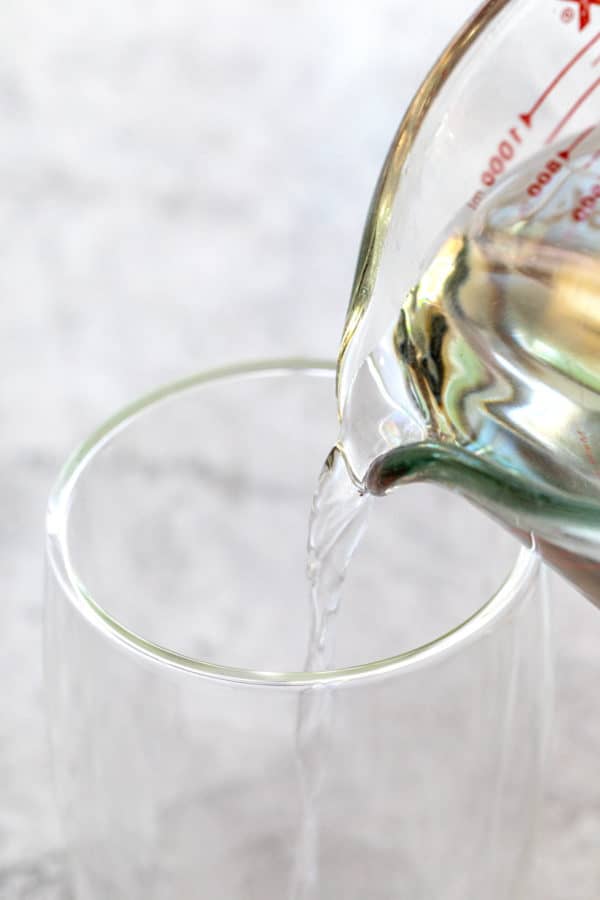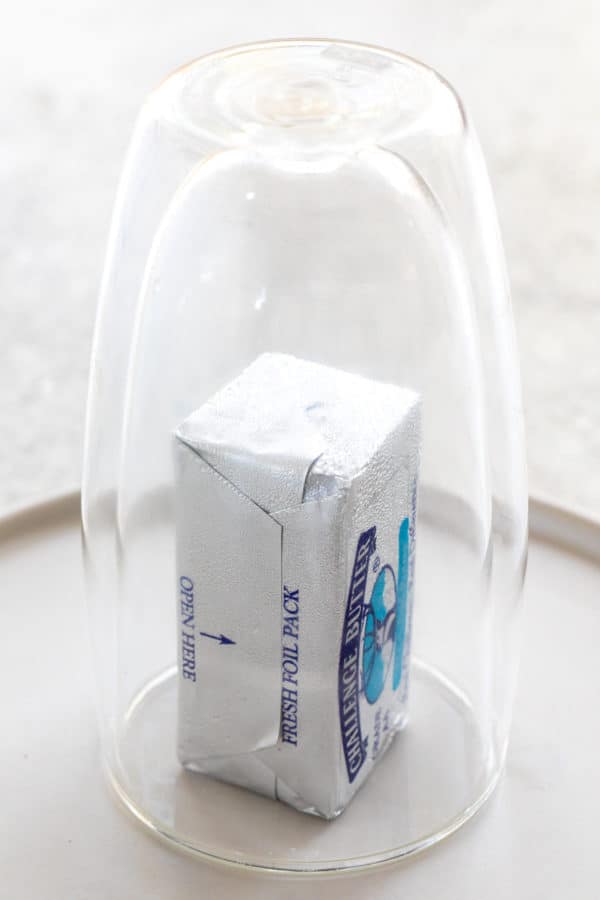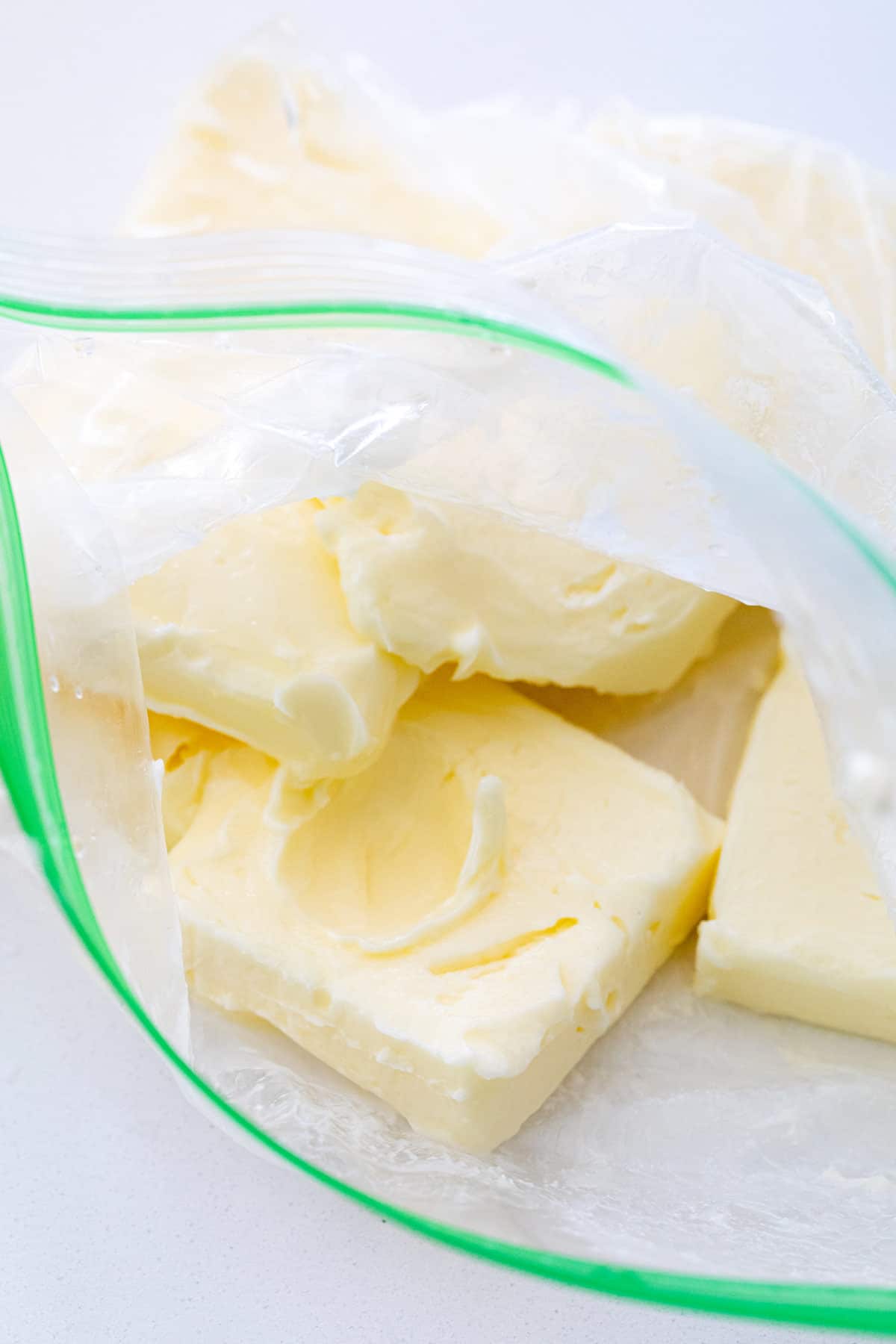How Do You Know When Butter Is Softened
Does the recipe you're following phone call for softened butter, simply you forgot to program ahead -or just realized you lot need it? Don't worry! Here are several ways to go you lot back on track and moving frontwards.

Tabular array of Contents
- Why do recipes call for softened butter?
- ane) Room temperature
- 2) Cut into cubes
- 3) Loving cup Steaming
- iv) Microwave Steaming
- 5) Lukewarm h2o bath
- half dozen) Pound the butter
- seven) Grating
- viii) Stand Mixer
- 9) Microwave
- How long does it take for butter to soften?
- What is room temperature?
- The best temperature for cakes, cookies, and frostings
- How to test when butter is properly softened
- How to save over softened butter
- How to Soften Butter Recipe
When a recipe calls for softened butter, but it's sitting cold in the refrigerator, here are a few uncomplicated techniques. They range from cutting into cubes to more physical methods like pounding it downwards or using microwave technology.
Whether you're making a batch of chocolate scrap cookies, tender cakes, or pie chaff, choose the method that syncs upward best. The list below contains easy hacks. Some are even fun to do!
Why do recipes phone call for softened butter?
Softened butter is easier to mix and evenly distribute with other ingredients. Plus, the temperature as well impacts a recipe's desired texture or function.
Methods for Quickly Softening Butter (from slowest to fastest)
1) Room temperature

Softening butter at room temperature gives the nearly consistent results with no effort. However, it takes the longest time, so planning is required. Time depends on the environment of the room. I often pull a stick or ii out of the fridge first thing in the morning. There'due south no pregnant difference if the butter is left wrapped or unwrapped.
Prep Time: 1 minute
Softening Time: 1 to two hours
2) Cutting into cubes

Cutting the butter downwardly into minor cubes allows for faster softening. Cut them into ½-inch pieces or smaller if desired for quicker results. This method increases the temperature by virtually 5 to x degrees. Let information technology sit on the counter until the desired temperature is reached.
Prep Fourth dimension: 5 minutes
Softening Time: 5 to 15 minutes
3) Cup Steaming
Oestrus water in a glass or ceramic cup, and so pour it out. Place the cup over the unwrapped stick. The boiling environment reacts with the trapped butter, merely after 5 minutes, the temperature rapidly cools down and loses its softening power. The outside of the butter volition be softer than the core. Unwrap and allow it to sit down on the counter, or cut into cubes to speed things upward.
Prep Time: 10 minutes
Softening Time: 5 to 8 minutes
4) Microwave Steaming
This is a quick and gentle method. Microwave some water to create a warm and steamy environment. Then swap it out with a plate of sliced butter. The residual heat and humidity warm the slices. I find the enclosed area will be around 79-degrees after heating the water. In simply 10 minutes, the butter volition be fix to use.
Prep Time: 5 minutes
Softening Fourth dimension: x minutes
5) Lukewarm h2o bath
A tepid water bath volition feel slightly cool, but the difference between the chilled slices of butter and lxxx-degree liquid temperature volition apace soften the butter without melting it. This doesn't work well for sticks considering the edges quickly soften, but the center stays business firm, requiring more time and risks over-softening.
Prep Fourth dimension: 5 minutes
Softening Fourth dimension: four minutes
six) Pound the butter
Time to get some aggression out! Pound a stick of butter between plastic or wax paper until very thin. The oestrus created by the friction and increased surface expanse volition aid it soften quicker. After flattening, it will be about 59ºF (15ºC). Allow information technology sit at room temperature for about 5 minutes to get to 65ºF (18ºC). This method is quick, easy, and gives a consistent texture and temperature throughout.
Prep Time: 5 minutes
Softening Time: 5 minutes
7) Grating

Grate the butter on the widest pore size of a handheld kitchen grater or box grater. Use the paper that's wrapped effectually the butter to help with gripping, so you don't nick your fingers on the sharp holes. It will come to room temperature very quickly. This works great if yous're making quick breads that require a flaky texture like buttermilk biscuits or scones.
Prep Time: v minutes
Softening Time: 2 to 3 minutes
8) Stand Mixer
This method works bang-up if yous already need some softened butter for creaming with sugar. Just cut the butter into fifty-fifty-sized pieces. For ane stick, I cut it into eight slices. Mix on medium-low speed until it reaches the desired softness. The friction created betwixt the paddle and the basin heats the fat. What's great is that it's already in the bowl for the side by side step for your baked goods.
Prep Time: 2 minutes
Softening Time: 4 minutes
9) Microwave

This method is the trickiest merely too the quickest. The key is to utilize medium power and flip the stick every 5 seconds to ensure fifty-fifty softening. I notice that it takes most 30 to 35 seconds to achieve 65 to 67 degrees.
This ensures the microwave energy is getting evenly distributed throughout the solid fatty and not simply 1 side. This method is ideal when you need to employ a large amount of butter for a recipe. Some microwaves accept a butter softening program.
Prep Fourth dimension: 2 minutes
Softening Time: 20 to 35 seconds
How long does information technology take for butter to soften?
A common cold stick of butter direct from the refrigerator is about 40ºF (iv.4ºC) and firm in texture. The softening time depends on the room temperature and ranges from 1 to 2 hours for a iv-ounce stick. The time will vary if information technology'due south sitting in the windowsill with sunshine or near a warm oven. Just make sure that the butter does not entirely melt into liquid, or you lot'll lose its air-trapping ability.
What is room temperature?
If the instructions say to soften to "room temperature," that can be from 68 to 72ºF (20 to 22ºC). This range can fluctuate drastically in your home, and then check your thermostat. You tin also turn on an instant-read thermometer, look about 30 seconds for the reading in your kitchen. If it's more cool or warm, it volition boring down or speed up the rate of softening.
The all-time temperature for cakes, cookies, and frostings
Soften the butter to just beneath room temperature, about 65 to 67ºF (18 to 19ºC). This range allows the needle-similar beta prime fat crystals to be solid simply all the same pliable. When mixed, the softened fat traps air pockets, so cookies, cakes, and frosting will turn out low-cal instead of dense.
How to examination when butter is properly softened
The most reliable method is inserting the probe of an instant-read thermometer in the center of the butter. It's always going to be cooler in the core. Another approach is to poke your finger onto the butter's surface. It should leave an indent just not stick to your finger, and there should be some slight resistance.
How to salve over softened butter
The melting point of butter is between 82 to 97°F (28 to 26ºC), from where it turns solid to liquid. Information technology's best not to re-chill completely melted butter, as it loses its fat crystal backdrop and will bear on the texture of baked goods. However, if it's a fiddling besides warm, you have a few choices.
For sticks or pieces, place in the refrigerator, checking every minute until it gets closer to room temperature. The freezer too works, but bank check more often as the temperature is 0ºF (-18ºC) compared to 40ºF(4.4ºC). Slices can exist placed in a bowl with a few ice cubes and gently mixed until more firm. If needed, dab the pieces with a paper towel to dry the surface.
Tin can butter be as well soft or hard?
Yes! If the butter is too soft, it won't concord air and will deflate. This creates flat broiled goods, or droopy frostings. If it'south at all melted, that won't trap air and instead be greasy. Cold butter is difficult to whip or foam, creating small chunks instead of being smooth.
Pin this recipe to save for later
Pin This
- ½ cup butter, one stick, unsalted or salted
- boiling water, as needed for steaming method
Room temperature
-
Identify the butter on the counter in a warmer area in the kitchen, unwrap and place it on a plate. Y'all don't want to put it also close to a hot stove or a warm window, or it can melt. Depending on the temperature of the room, it will accept 1 to 2 hours to soften.
Cutting into cubes
-
Slice the stick lengthwise into ½-inch thick rectangles. Cut into ½-inch cubes or smaller sizes for even quicker softening. Let information technology sit down on the counter until the desired temperature is reached, about 5 to fifteen minutes.
Glass Steaming
-
Employ a drinking glass or ceramic cup that'southward big enough to cover the butter. Make full with humid water. Alternatively, fill a microwave-safe loving cup with water, oestrus on loftier ability until most boiling, nigh 3 minutes. Let the cup sit down for 3 minutes to warm upwardly, and so cascade out the water.
-
Place the wrapped butter on a plate, standing up. Immediately place the warmed cup over the butter. Check after 5 minutes, so every i minute subsequently, about 8 minutes maximum. Unwrap and sit on the counter until the desired temperature is reached, or cut into cubes to speed up softening.
Microwave Steaming
-
Slice the butter into even-sized pieces, about 1-cm thick. Evenly place them on a plate. Using a microwave-safe material, heat 2 cups of water on high power for iii minutes.
-
Remove the loving cup from the microwave and replace information technology with the plate of butter. Close the door and allow it sit down for about 10 minutes to soften.
Warm water bathroom
-
Cut the stick into 1-cm thick slices and place them in an even layer into a pocket-size resealable plastic bag. Remove the air, and seal.
-
In a medium bowl, add 4 cups of 80-degree water for ii minutes, then flip it over and let it sit for another two minutes. Echo the flipping process in i-minute intervals as needed.
Pound the butter
-
Identify the stick of butter in the middle of a large resealable plastic bag. Pound it down with a rolling pin until flattened, then roll to an even 1/xvi-inch thickness. Let information technology sit at room temperature until the desired temperature is reached, well-nigh 5 minutes to achieve 65ºF (18ºC).
Grating
-
Utilise the largest holes on a kitchen grater. Unwrap the butter, leaving some effectually the stick's top to apply as a place to grip. Grate over a plate and use information technology immediately or within a few minutes.
Stand Mixer
-
Cutting the butter into fifty-fifty-sized slices, about 1 tablespoon in size (ane-cm thick). Place in the bowl of a stand mixer fitted with the paddle attachment. Crush on medium-low speed (setting 4) for 2 minutes.
-
Scrape downward the paddle and basin, then mix on medium-low until it reaches the desired temperature, 1 to two minutes.
Microwave
-
Identify the unwrapped stick of butter on a microwave-prophylactic plate. Use the medium power setting (50%) and estrus for v seconds. Flip the stick over clockwise, so it'south on another side, rut for v seconds.
-
Repeat with the remaining two sides, nearly 20 seconds total. Keep flipping and heating in 5-2d intervals until it reaches the desired temperature. Information technology takes almost 30 to 35 seconds to reach 65 to 67ºF (xviii to 19ºC).
Want to save this recipe?
Create an account easily save your favorite content, and so you never forget a recipe again.
Annals now
Nutrition Facts
How to Soften Butter
Amount Per Serving
Calories 102 Calories from Fat 108
% Daily Value*
Fatty 12g 18%
Saturated Fat 7g 35%
Trans Fat 1g
Cholesterol 31mg 10%
Sodium 101mg iv%
Potassium 3mg 0%
Carbohydrates 1g 0%
Sugar 1g one%
Poly peptide 1g ii%
Vitamin A 355IU vii%
Calcium 3mg 0%
Iron 1mg 6%
* Percent Daily Values are based on a 2000 calorie diet.
Tried this recipe?
Tag @jessica_gavin on Instagram. I'd love to see how information technology turns out!
Tag @jessica_gavin
Filed nether: Cooking 101 How To
This post may contain affiliate links. Please read my disclosure policy.
You May Besides Like
Source: https://www.jessicagavin.com/how-to-soften-butter/












0 Response to "How Do You Know When Butter Is Softened"
Post a Comment